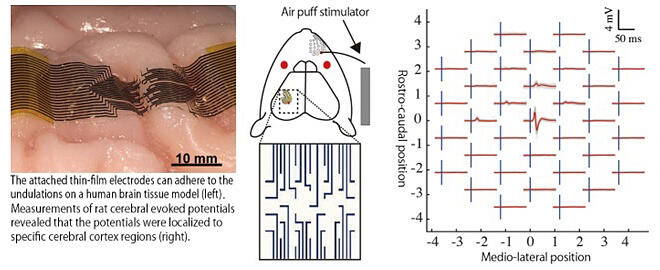Approximately 300,000 patients in Japan have intractable epilepsy, a condition in which seizures cannot be controlled, even with multiple antiepileptic drugs. To identify and treat lesions, subdural electrodes are directly attached on the surface of the cerebral cortex within the subdural space to record electrical potentials and conduct electrical stimulation. However, because the mechanical mismatch between the electrode and brain cortex causes a misalignment of the electrode and intracranial hypertension, thinner electrode structures are required in clinical practice.
A research group led by Associate Professor Toshinori Fujie of the Department of Life Science and Technology, School of Life Science and Technology at Tokyo Institute of Technology, has fabricated a thin-film electrode using a soft, thin film composed of synthetic rubber for the base and insulating layers. The group fabricated conductive wiring and a multi-point electrode pattern by inkjet printing gold nano-ink on the surface of the thin film and overlaid another thin film on the surface as an insulating layer.
The fabricated thin-film electrode has a thickness of approximately 8 µm, making it 1/12 the thickness of conventional subdural electrodes, and can closely cover the undulations on the surface of a brain tissue model that mimics the human brain. When the thin-film electrodes were attached to a rat model of drug-induced epilepsy, epileptiform discharges were recorded on electroencephalography (EEG). Characteristic movements induced by electrical stimulation were also observed, and no abnormalities due to electrode fixation were observed.
Thin-film electrodes fabricated using such soft materials are expected to reduce the burden and complications in the treatment of patients with intractable epilepsy. In the future, the research group aims to realize a fully implantable device that integrates diagnosis and treatment by enabling both surface EEG recording and electrical stimulation.





